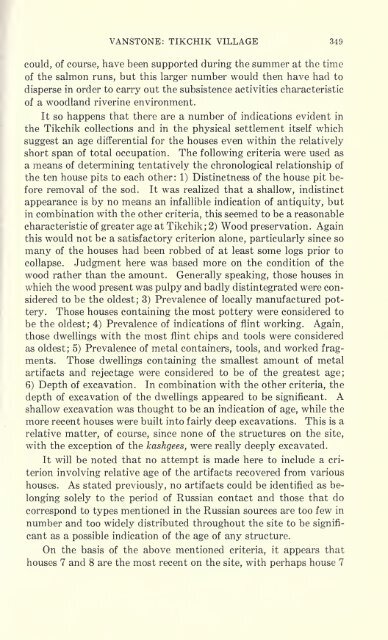Tikchik village: a nineteenth century riverine community in ... - Cluster
Tikchik village: a nineteenth century riverine community in ... - Cluster
Tikchik village: a nineteenth century riverine community in ... - Cluster
- No tags were found...
Create successful ePaper yourself
Turn your PDF publications into a flip-book with our unique Google optimized e-Paper software.
VANSTONE: TIKCHIK VILLAGE 349could, of course, have been supported dur<strong>in</strong>g the summer at the timeof the salmon runs, but this larger number would then have had todisperse <strong>in</strong> order to carry out the subsistence activities characteristicof a woodland <strong>river<strong>in</strong>e</strong> environment.It so happens that there are a number of <strong>in</strong>dications evident <strong>in</strong>the <strong>Tikchik</strong> collections and <strong>in</strong> the physical settlement itself whichsuggest an age differential for the houses even with<strong>in</strong> the relativelyshort span of total occupation. The follow<strong>in</strong>g criteria were used asa means of determ<strong>in</strong><strong>in</strong>g tentatively the chronological relationship ofthe ten house pits to each other: 1) Dist<strong>in</strong>ctness of the house pit beforeremoval of the sod. It was realized that a shallow, <strong>in</strong>dist<strong>in</strong>ctappearance is by no means an <strong>in</strong>fallible <strong>in</strong>dication of antiquity, but<strong>in</strong> comb<strong>in</strong>ation with the other criteria, this seemed to be a reasonablecharacteristic of greater age at <strong>Tikchik</strong>; 2) Wood preservation. Aga<strong>in</strong>this would not be a satisfactory criterion alone, particularly s<strong>in</strong>ce somany of the houses had been robbed of at least some logs prior tocollapse. Judgment here was based more on the condition of thewood rather than the amount. Generally speak<strong>in</strong>g, those houses <strong>in</strong>which the wood present was pulpy and badly dist<strong>in</strong>tegrated were consideredto be the oldest; 3) Prevalence of locally manufactured pottery.Those houses conta<strong>in</strong><strong>in</strong>g the most pottery were considered tobe the oldest; 4) Prevalence of <strong>in</strong>dications of fl<strong>in</strong>t work<strong>in</strong>g. Aga<strong>in</strong>,those dwell<strong>in</strong>gs with the most fl<strong>in</strong>t chips and tools were consideredas oldest; 5) Prevalence of metal conta<strong>in</strong>ers, tools, and worked fragments.Those dwell<strong>in</strong>gs conta<strong>in</strong><strong>in</strong>g the smallest amount of metalartifacts and rejectage were considered to be of the greatest age;6) Depth of excavation. In comb<strong>in</strong>ation with the other criteria, thedepth of excavation of the dwell<strong>in</strong>gs appeared to be significant.shallow excavation was thought to be an <strong>in</strong>dication of age, while themore recent houses were built <strong>in</strong>to fairly deep excavations. This is arelative matter, of course, s<strong>in</strong>ce none of the structures on the site,with the exception of the kashgees, were really deeply excavated.It will be noted that no attempt isAmade here to <strong>in</strong>clude a criterion<strong>in</strong>volv<strong>in</strong>g relative age of the artifacts recovered from varioushouses. As stated previously, no artifacts could be identified as belong<strong>in</strong>gsolely to the period of Russian contact and those that docorrespond to types mentioned <strong>in</strong> the Russian sources are too few <strong>in</strong>number and too widely distributed throughout the site to be significantas a possible <strong>in</strong>dication of the age of any structure.On the basis of the above mentioned criteria, it appears thathouses 7 and 8 are the most recent on the site, with perhaps house .7






![La musa galante [microform] - University Library](https://img.yumpu.com/50760818/1/190x222/la-musa-galante-microform-university-library.jpg?quality=85)










